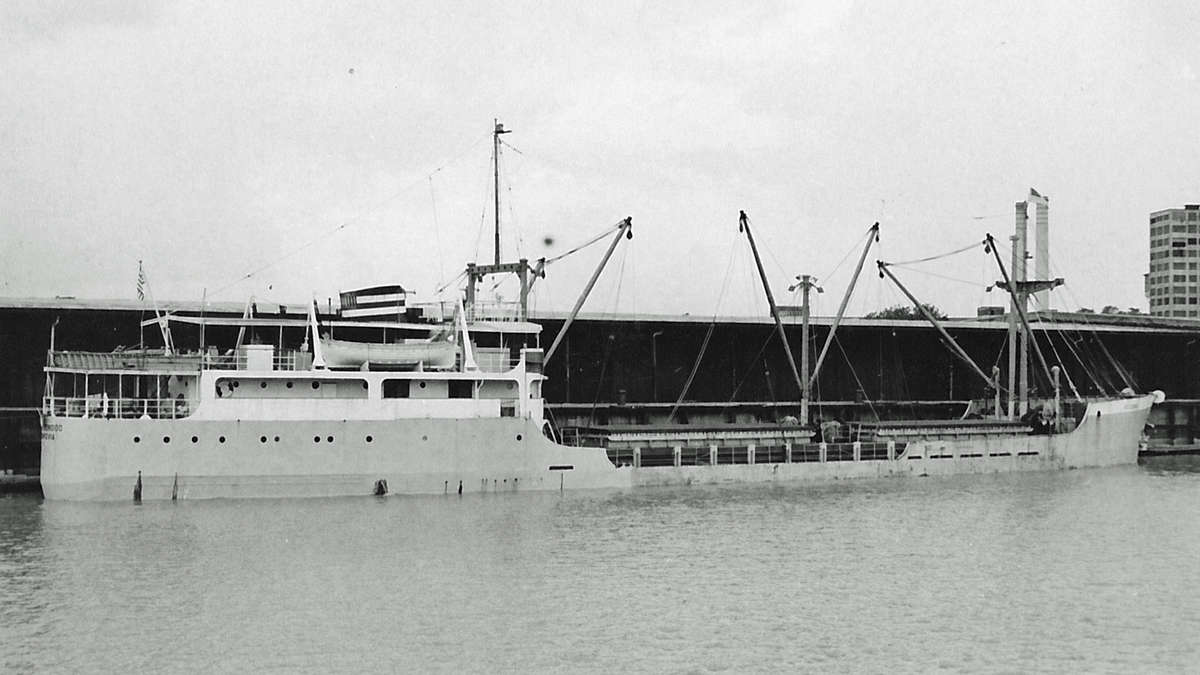As I have mentioned previously, I recently discovered that my late father, Francisco Guerra, was a veteran of the legendary Brigada de Asalto 2506. He joined the Brigade in early 1961 at the age of 18, was assigned serial number #4133 upon his enlistment, and was attached to the Sixth Battalion. Now, after reading several books about this heroic band of brothers (my complete Bay of Pigs reading list is posted here), I want to share a few additional facts specific to my father’s unit, the Sixth Battalion:
Pre-invasion: Rendez-vous at Blue Beach
The Sixth Battalion was supposed to land at Playa Girón — code named “Blue Beach”, one of three strategic landing spots for the doomed Bay of Pigs invasion — and would be held in reserve until needed.
For their rendez-vous to Playa Girón, the men of the Sixth Battalion boarded the Rio Escondido (pictured below; see also Note #1), an old and rusty civilian cargo ship secretly leased by the CIA to transport the members of the Brigade and their supplies. (See, e.g., Lynch 2000, p. 69.) But their voyage began with an ominous omen, for there were not enough life jackets to go around: “The 180 men [see Note #2] of the Sixth Battalion who came aboard [the Garcia Line’s Rio Escondido] seemed cheerful enough, but there were no life jackets for them.” (Wyden 1979, p. 133.)
Note #1: In all, the Brigade’s little flotilla consisted of six scrawny vessels: the Atlantico, the Caribe, the Houston, the Lake Charles, the Rio Escondido, and the Santa Ana. (For a detailed description of this aging fleet, see here).
Note #2: According to Peter Wyden, the North American journalist who wrote the definitive account of the Bay of Pigs invasion, the Sixth Battalion was 180 men strong (see the Wyden quotation above), but when I checked the official records of Brigade 2506 (see here), only 140 men are listed as belonging to this battalion.
Continuing with my story, on the eve of their ill-fated invasion the Brigade fielded six infantry battalions — in addition to a heavy weapons battalion, an armored truck battalion, a tank company, a paratrooper unit, a frogmen unit, and an air unit — but since the Sixth Battalion was the last to be formed, the members of this late-addition unit had to complete their training en route to the invasion: “Because of the limited time available before the invasion, the [6th] battalion …. were forced to complete their weapons training while en route to the invasion. They used oil drums, either tossed overboard or towed on a long cable behind [their] ship, for target practice.” (Lynch 2000, p. 25.)
Invasion Day, Pre-dawn Hours: Landing at Blue Beach
When the Rio Escondido arrived at the Bay of Pigs at the appointed hour on D-Day, the men of the battalion began unloading the Brigade’s first batch of supplies and boarded their assigned Landing Craft Utility (LCU) transport vessels, flat-bottom boats used by amphibious forces to transfer equipment and troops from ship to shore, and successfully disembarked on Blue Beach. But then disaster struck. As the men of the Brigade were about to discover, Fidel Castro still had several deadly single-propeller “Sea Furies” as well as some supersonic Lockheed T-33s at his disposal. The enemy would control the skies above the beaches because President Kennedy had cancelled the Brigade’s scheduled D-Day air strikes at the last hour.
Invasion Day, Morning Hours: Sinking of the Rio Escondido
After the sun went up, the Sixth Battalion’s mother ship, the Rio Escondido, was attacked by an enemy Sea Fury aircraft screaming down from 5000 feet: “On Blue Beach, the LCUs had landed the 6th Battalion from the Rio Escondido. They were returning to the ship to remove its deck cargo of drums of aviation fuel when a Sea Fury came screaming down from five thousand feet.” (Lynch 2000, p. 113.) According to Grayston Lynch, a CIA operative who was on the scene, the enemy aircraft fired four of its rockets at the mother ship: “Three of the rockets overshot the ship and exploded harmlessly in the water.” The fourth rocket, however, struck the forward deck of the ship. (Ibid.)
The explosion caused by this direct hit was massive: “… the Rio Escondido exploded in a huge, mushroom-shaped fireball. The mushroom spread until it was over a mile in diameter and several thousand feet high.” (Lynch 2000, p. 113.) All of the ammunition aboard the Rio Escondido, along with the Brigade’s critical communications van and life-saving medial supplies, were lost at sea in the explosion: “The Brigade suffered a major blow later that morning: Castro’s planes, unrelenting in their attacks, hit the cargo ship Rio Escondido with a rocket off the shore of Blue Beach.” (Triay 2001, p. 75.)
While this disaster was unfolding in real time, the men of the Sixth Brigade were en route to help unload the ammunition and other vital supplies from the Rio Escondido. Now, there was nothing for them to unload. Stay tuned for my next post. It gets worse …




Pingback: Un último adiós | prior probability